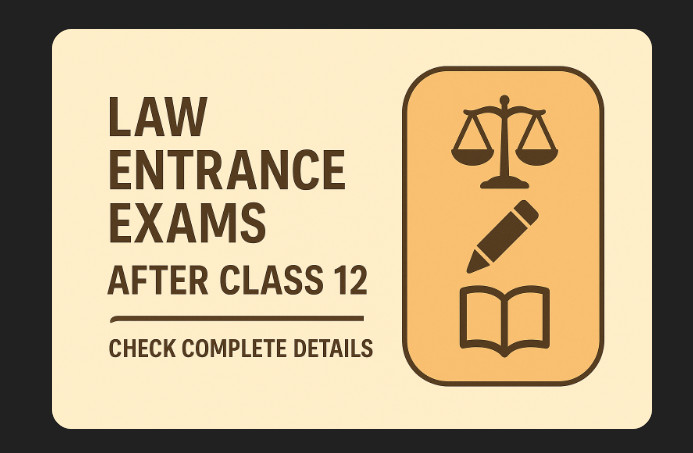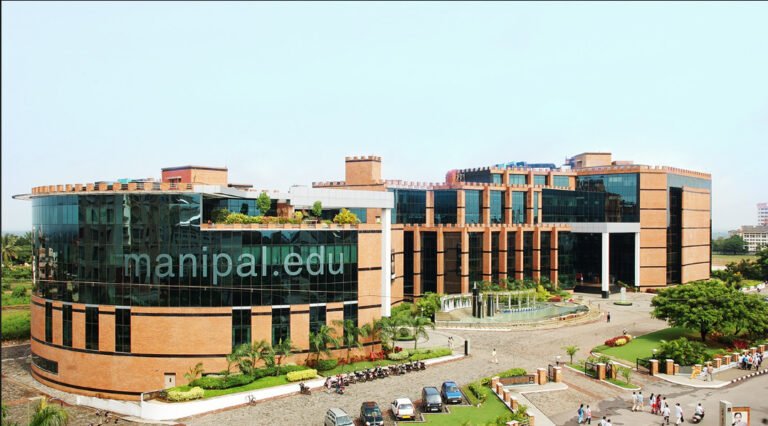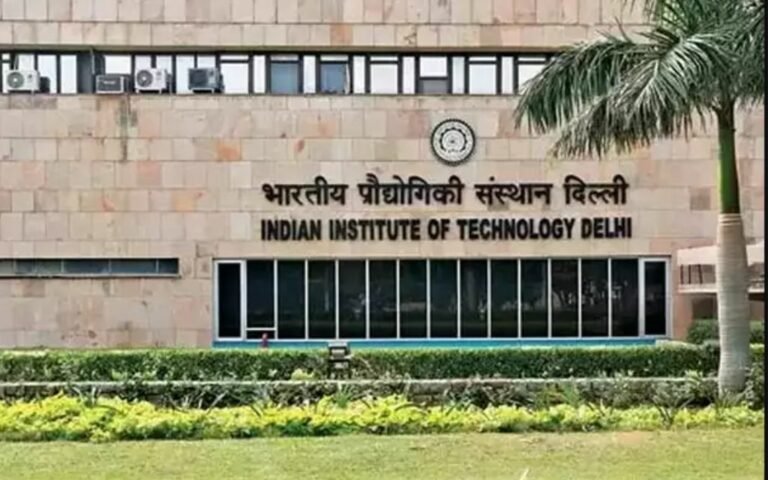Law Entrance Exams After Class 12 – Check Complete Details

Candidates, after completing their 10+2 examination, move out into multiple career paths, Law being one of them. For candidates wishing to pursue a career in law and related fields, choosing the right law entrance examination becomes extremely essential. There are multiple law-based entrance examinations in India, such as CLAT, AILET, and MHCET, which offer a gateway to some of the most prestigious government and private law institutions in India. These various examinations differ in format, patterns and schedules. Navigating through these parameters can significantly impact the career paths of the candidates. This blog will guide you through the various law-entrance examinations in India and help you choose the right one for yourself.
Table of Contents
CLAT (Common Law Admission Test)
The Common Law Admission Test is one of the most widely accepted law-based entrance examinations in India. It is conducted by the Consortium of National Law Universities and serves as the golden ticket to the most sought-after 24 National Law Universities in the country, excluding NLU Delhi and NLU Meghalaya, as they have a separate mode of admission. All the important details regarding the Common Law Admission Test have been mentioned below:
| Aspects | Details |
| Conducting Body | Conducted by the Consortium of National Law Universities |
| Courses Offered | CLAT offers admission to both Undergraduate and PostGraduate courses, such as the 5-Year integrated LLB/BBA LLB Program and LLM Programs. |
| Eligibility Criteria | Candidates must have 10+2 with at least 45% marks (General/OBC/SAP) and at least ≥40% for SC/ST. |
| Examination Pattern | The Examination pattern for Undergraduate programs is as follows: Mode: Offline/Pen-Paper ModeDuration: 2hrs/120 mins Questions: 120 Questions from multiple sections, such as English, General Knowledge & Current Affairs, Logical and Legal Reasoning Marks: +1 for correct answers, -0.25 for incorrect answers |
| Tentative Deadline | The Registration begins around January-March, and the examination is scheduled to be held in December. |
| Accepting Colleges | The Common Law Admission Test serves as the gateway to the 24 National Law Universities in India. |
AILET (All India Law Entrance Test)
The All India Law Entrance Test is solely conducted by the National Law University, Delhi, for admission into its highly reputed BA LLB, LLM and PhD Programs. The All India Law Entrance Test (AILET) is a national-level law-based entrance examination for candidates wishing to get into the National Law University, Delhi. This examination is particularly conducted to get into NLU Delhi for both undergraduate and postgraduate courses and doctoral programs. The National Law University, Delhi, exclusively accepts only the AILET scores for admission purposes. The All India Law Entrance Test is a competitive examination in itself and is similar to the Common Law Admission Test, including various subjects such as legal principles, reasoning and comprehension-based questions.
| Aspects | Details |
| Conducting Body | National Law University, Delhi |
| Courses Offered | BA LLB, LLM, PhD |
| Eligibility Criteria | For Undergraduate Programs: 10+2 with at least 50% marks in the Qualifying Examination for General/OBC and 45% for SC/ST/PwD |
| Examination Pattern | The Examination pattern for Undergraduate programs is as follows: Mode: Offline/Pen-Paper ModeQuestions: 150 Questions from multiple sections, such as English, General Knowledge & Current Affairs, Logical and Legal Reasoning Marks: +1 for correct answers, -0.25 for incorrect answers |
| Seats Offered | BA LLB: 110 Seats LLM: 70 Seats |
| Accepting Colleges | National Law University, Delhi |
SLAT (Symbiosis Law Admission Test)
The Symbiosis Law Admission Test (SLAT) is conducted by Symbiosis International (Deemed University) for admission to its four prestigious law schools in Pune, Noida, Nagpur, and Hyderabad. SLAT is a computer-based test. As per past year trends, SLAT is usually conducted on two days. Candidates appearing for both tests will have the higher score considered. Candidates aspiring to take the SLAT 2025 exam must register and offer their choice of programs.
| Aspects | Details |
| Conducting Body | Symbiosis International University |
| Courses Offered | BA LLB, BBA LLB |
| Eligibility Criteria | For Undergraduate Programs: 10+2 with at least 50% marks in the Qualifying Examination for General/OBC and 40% for SC/ST/PwD |
| Examination Pattern | The Examination pattern for Undergraduate programs is as follows: Mode: Offline/Online ModeDuration: 120 mins/2 hrs Questions: MCQ Questions from multiple sections, such as English, General Knowledge & Current Affairs, Logical and Legal Reasoning |
| Seats Offered | A total of 900 seats are offered across all the campuses |
LSAT
The Law School Admission Test is primarily conducted by the Law School Admission Council (LSAC) and monitored by Pearson VUE for admission into multiple prestigious private institutions such as Jindal Global Law School. UPES Dehradun, Amity University and many others. This Examination focuses on the candidate’s logical and analytical thinking skills. LSAT also does not require any Mathematics or General Awareness knowledge, making it distinct from any other law examination. Candidates who have passed their 10+2 examination with at least 45% marks are eligible for this examination.
| Aspects | Details |
| Conducting Body | LSAC and Pearson VUE |
| Courses Offered | BA LLB, BBA LLB, BCom LLB, LLM, etc |
| Eligibility Criteria | For Undergraduate Programs: 10+2 with at least 45% marks in the Qualifying Examination for General |
| Examination Pattern | The Examination pattern for Undergraduate programs is as follows: Mode: Offline/Pen-Paper Mode Duration: 140 mins/2 hrs 20 mins Questions: MCQ Questions from multiple sections, such as Reading Comprehension, Logical and Analytical Reasoning No Negative Marking |
| Frequency | Four times a year |
| Accepting Colleges | Jindal Global Law School, UPES, IIT-KGP Law, SRM |
MH-CET Law
The MH-CET Law (Maharashtra Common Entrance Test) is a state-level examination conducted by the State CET Cell, Maharashtra, for admission into 3-year and 5-year LLB programs across more than 150 law colleges in Maharashtra. The tentative examination dates for both the 5-year LLB and the 3-year LLB have been announced by the Maharashtra Government. The 5-Year LLB examination is set to be held in April 2026, and the 3-Year LLB examination in May 2026.
| Aspects | Details |
| Conducting Body | Maharashtra Directorate of Higher Education |
| Courses Offered | 5-Year and 3-Year LLB Programs |
| Eligibility Criteria | For Undergraduate Programs: 10+2 with at least 45% marks in the Qualifying Examination for General/OBC and 40% for SC/ST/PwD |
| Examination Pattern | The Examination pattern for Undergraduate programs is as follows: Mode: OnlineQuestions: MCQ Questions from multiple sections, such as Legal Aptitude, General Knowledge, English, Logical Reasoning, Mathematics |
| Seats Offered | 11,000 seats for 5-Year LLB, 16,000 for 3-Year LLB |
IPU CET Law
The IPU CET Law Entrance examination is conducted by the Guru Gobind Singh Indraprastha University (GGSIPU), Delhi, for candidates wishing to get admitted into the BA LLB and BBA LLB Programs in affiliated colleges, including schools such as the University School of Law and Legal Studies (USLLS). This examination is very popular among the candidates in the Delhi-NCR. The Exam pattern for IPU CET is quite different from any other law entrance examination.
| Aspects | Details |
| Conducting Body | Conducted by GGSIPU, Delhi |
| Courses Offered | BA LLB, BBA LLB at IP Universities |
| Examination Pattern | The Examination pattern for Undergraduate programs is as follows: Mode: Offline/Pen-Paper Mode Marks: +4 for correct answers, -1 for incorrect answers |
| Seats | Several hundred seats across various law departments |
FAQs
Yes, every candidate can appear for as many examinations as they wish. Multiple candidates have been seen appearing for multiple law-based entrance examinations.
Yes, both are indeed law-based entrance examinations, but the LSAT focuses on logical and analytical thinking skills without any current affairs, whereas the Common Law Admission Test also includes a dedicated General Knowledge and Current Affairs section.
It is advisable to start your preparation as early as possible, as this will give you a head start. Consider beginning at least 8 months before the examination to prepare effectively for each section.
No, competitive examinations are not easy at all, but when compared with each other, state examinations like MH-CET and IU CET are comparatively easier than national-level examinations like CLAT and AILET.
Dear Students & Parents of Std 8 to 12- One Stop solution for career counseling – Vikas Kumar @ Psychographic Society -city center -club Road Ranchi
For more information call – 9570795071/9709534303
For Counselling Program Details – Click
Also Read-






